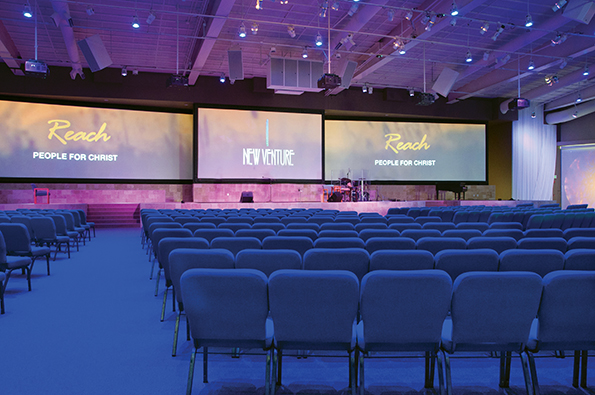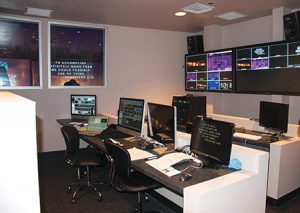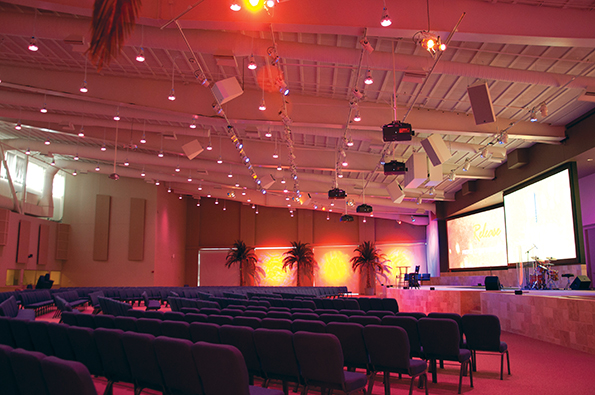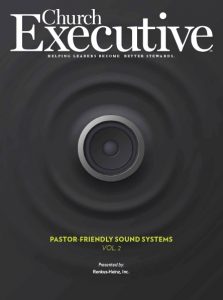
At New Venture Christian Fellowship in Oceanside, CA, visual impact is standard — and transparent.
By Daniel Keller
At times, the 1,800-seat sanctuary has been transformed into a day at the beach, complete with a “white sand” carpet (courtesy of expertly applied LED house lighting) and the Pacific Ocean roaring in the distance (thanks to some pretty advanced projection technology and know-how from the tech team). The ocean “roars” around you … largely because just the right audio elements are in place.
But, it wasn’t always such an immersive experience.

Rick Boring — Senior Systems Consultant for Olympia, WA-based CCI Solutions (the firm which oversaw the extensive audio/video/lighting renovation of church’s 1,800-seat sanctuary in 2013) — recalls a different time. Much of the circa-1994 audio, video and lighting equipment had reached the end of its useful life. Projectors died, mid-service. Lights went out unexpectedly.
So, when Boring and his team were enlisted, they focused on helping church leaders deliver a more stimulating, high-tech, contemporary worship experience — with systems far more complex than a more traditional house of worship — as well as the selection of audio, video and lighting components that would stand the test of time. And, to ensure things ran smoothly, Boring and his team prioritized seamless connectivity between these systems.
For example, the seamless networked audio elements (including speakers) could not interfere with the sanctuary’s new video screens and theatrical lighting. This objective didn’t allow sufficient height to hang a line array speaker setup. In other words, the speakers could  not be assembled in a straight vertical line and angled — either physically or via beam-steering — so that each box covers a section of successive rows.
not be assembled in a straight vertical line and angled — either physically or via beam-steering — so that each box covers a section of successive rows.
“No matter where we tried to hide a line array, we [would] be blocking sightlines to the screen for somebody,” Boring explains. Instead, he and his team installed four Renkus-Heinz ST9-94R three-way self-powered speakers, with built-in amplifiers to facilitate fewer wires, less heat and better sound. He and his team arranged the speakers in an “exploded cluster” — a very widely arrayed horizontal array — and added five delayed ST7M-94R mid/high self-powered speakers. These were placed further back in the audience, and time-delayed to match the sound of the main speakers.
 “With [these] speakers, when you’re in the pattern, it’s very consistent,” Boring explains. “The pattern drop-off is very accurate, and we’re only putting sound where it’s needed.”
“With [these] speakers, when you’re in the pattern, it’s very consistent,” Boring explains. “The pattern drop-off is very accurate, and we’re only putting sound where it’s needed.”
To put this in perspective, consider light as an analogy. The coverage pattern of these speakers is very tightly focused and defined — step outside the “spotlight,” and you hear almost nothing. Why this is important? Because keeping sound focused on the audience — and preventing it from hitting (and reflecting off of) walls, windows and other hard surfaces — reduces reverberation, the enemy of intelligibility.
The subwoofers posed another challenge. Boring didn’t want to ground stack the subs on each side of the stage, which would result in excessive low frequency buildup for the performers onstage — a very uncomfortable environment at best.
Instead, Boring opted for a cardioid sub array, with four DR18-2R 115V self-powered dual 18-inch subs hanging over the stage firing toward the congregation, and another two dual 18-inch subs firing backward toward the stage. This subcardioid configuration creates a “null” zone, reducing bass buildup onstage while providing more than enough low end for the congregation. “It created a great pattern with rejection on the stage and super-consistent low-end across the congregation,” he points out.
Focusing on the message, not the methods

The worship style at New Venture Christian Fellowship is visually oriented, to put it mildly. Pastor Shawn Mitchell uses lots of sermon illustrations and visual aids — even some living, breathing ones! — to help the message come alive on Sunday.
When the visual worship experience is this important, transparency — and discretion — surrounding the technology driving that experience is critical. This, in effect, was Boring’s mantra when overhauling the space’s audio, video and lighting systems.
When Boring discussed this same project with Sound & Communications Magazine in 2013, he explained it like this: “When we do installations, I want the improved sound, video and lighting to help people enter into great worship, but don’t want them to necessarily concisely attribute the difference to an improved sound and video system. I want it to be transparent.
“This is how technology in a house of worship should be: largely transparent,” he added. “People will notice the end effects of the technology, but not how the effects were achieved.”
Daniel Keller is CEO of Get It In Writing, Inc.®.


